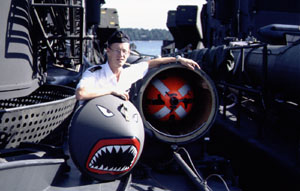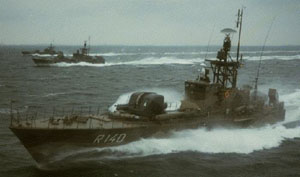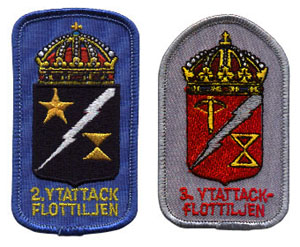

Builder: Karlskrona Varvet AB, Karlskrona.
Names:
| HMS Norrköping | (Nkg) | (T 131/R 131) |
| HMS Nynäshamn | (Nyn) | (T 132/R 132) |
| HMS Norrtälje | (Ntä) | (T 133/R 133) |
| HMS Varberg | (Vab) | (T 134/R 134) |
| HMS Västerås | (Vås) | (T 135/R 135) |
| HMS Västervik | (Väs) | (T 136/R 136) |
| HMS Umeå | (Umeå) | (T 137/R 137) |
| HMS Piteå | (Pit) | (T 138/R 138) |
| HMS Luleå | (Lul) | (T 139/R 139) |
| HMS Halmstad | (Hsd) | (T 140/R 140) |
| HMS Strömstad | (Ssd) | (T 141/R 141) |
| HMS Ystad | (Ysd) | (T 142/R 142) |
Dimensions: |
Displacement: |
Speed: | |
|---|---|---|---|
| Length | 43.6 (41.3 pp) | 190 ton (230 fl) | 40 knots |
| Width | 7.1 m | ||
| Depth | 1.6 m (2.3 prop.) | ||
Armament:
| 0-8 | SAAB Rb-15 SSM | (II x 2-4) |
| 1 | 57-mm Bofors SAK-57 Mk. 1 DP-Gun | (I x 1) |
| 2-6 | 533-mm Torpedoes | (I x 2-6) |
| 8 | 57-mm Flares | (IV x 2) |
| Minelaying-capacity |
| Navigational radar: | 1 | Skanter-009 |
| Searchradar: | 1 | Ericsson Sea GIRAFFE 50HC |
| EW-equipment: | 1 | ARGOSystems APECS-II Phoenix |
| 1 | MEL Susie | |
| 2 | CelsiusTech Philax chaff/flare-launchers |
Machinery: |
Electricity: | ||
|---|---|---|---|
| 3 | GT Rolls Royce Proteus GT12750 hp/9375 kW | 1 | MTU-generator-GT, |
| 3 | KAMEWA CP-propellers | 1 | Volvo Penta diesel, |
| each coupled to a Hertzinger-generator. | |||
Crew:
11 officers + 16 men.
Provision for a total of 32 (14+18)

| History | |
|---|---|
| The twelve ships of the Norrköping-class were first launched as torpedoboats
in the years between 1973-76. Their ancestry can be traced back to the motortorpedoboat
(MTB), first introduced in the Swedish
Navy in the 1920's. The larger torpedoboats where introduced in 1954, when construction started on the twelve ships of the Plejad-class. In 1966-68 the evolution progressed in the form of the Spica-class, which unlike earlier torpedoboats were equiped with gasturbine main propulsion. Spica, which was considered a success, were later followed by the modified twelve ship class, Spica II - Norrköping. A Swedish naval officer displaying a practice torpedo in the port torpedotube. |
 |
 |
During 1982-85 this class of equaly successful ships underwent a conversion
to become missile boats. HMS Piteå acted
as a prototype, undergoing a series of trials to ensure the feasibility
of the project. The trials turned out successfull, and she was soon joined
by her sisters. 1996-98 six ships of this class underwent SLEP (Service Life Extension
Program) and were somewhat modified. The remaining class is subsequently
refered to as YSTAD-class of FAC. |
| Units | |
|---|---|
The twelve units of the class were divided in to two squadrons, the 21st
and 34th FAC squadrons. Each squadron form part of a Surface Attack Flotilla,
the 2nd SAF based at Berga, and the 3rd SAF based at Karlskrona. As of 2001 two more ships were decomissioned and the remaining ships are concentrated to the 34th squadron based at Karlskrona. |
 The unit badge of the respective flotilla is shown above. |
Model of the Norrköping-type FAC

Here's some pictures of a 1:50 scale model I've built of this type. The model was a R/C model with a plank-on-frame type of hull.
A few more pictures:
Model-1 Model-2 Model-3 Model-4
Revised: 2003-10-15